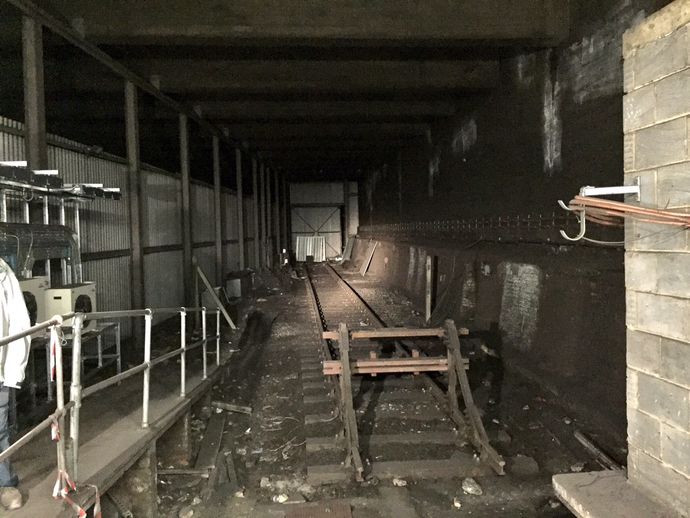
The hidden tunnels beneath King's Cross Station
Last week I was very lucky in getting a balloted ticket for the District Dave Forum Christmas Meetup - to go and see something really quite interesting, and very unusual. (District Dave’s Forum is a place for the most ardent London Underground enthusiast to enjoy – there are a lot of very knowledgeable people there who understand the past, current and future of the system much more than I there). I’ve lurked on those Forums for many years and occasionally ask a very stupid question.
One of the things that characterises TfL today is the incredible number of transport enthusiasts who work within the organisation. Thanks to them, the Forum social this year was an expertly-arranged tour of the “Hidden Tunnels of King’s Cross” by off-duty station staff. Our main organiser and guide was one of TfL’s greatest advocates, Jack Gordon. His enthusiasm for his day-to-day role assisting passengers around King’s Cross is superseded only by his love for the history of the network. TfL is lucky to have people like him (and so many others) taking time and effort volunteering to show those of us of a nerdish disposition around something that they adore.
So it was that we took a remarkable two-hour trip in and out of dozens of rooms, corridors and tunnels. From the frankly sci-fi warren of concrete tunnels and rooms beneath the new King’s Cross Ticket Hall (some of these voids are four storeys high) to the faded original Northern Line pedestrian tunnels, still showing signs of damage from the dreadful fire of 1987. We even had a wander around the old King’s Cross Thameslink railway station, now just used as an access route from Pentonville Road to the Underground platforms on weekday.
What fascinates me about our “hidden” or “abandoned” tunnels isn’t so much that they were railways or foot tunnels at all, but that our city and our needs have grown so rapidly that they have outgrown these systems that were built for them. That our growth as humans mean we’re now too tall for some tunnel clearances; and that London sometimes grows or changes priorities so fast that the infrastructure that was built for it was sometimes already outdated before it was completed. It was an exhausting, but truly wonderful trip.
After our epic tour most of my fellow tourists retired to the pub with the rest of the Forum folk, but I headed off to Bekonscot Model Village in Beaconsfield to look at the winter-time evening illuminations and have a drive around the miniature railway. Because, of course, weekends are made for playing trains.
Note: TfL has given permission for photos in these locations to be published online here.

The “secret” now-disconnected never-used siding deep beneath King’s Cross on the Metropolitan, Hammersmith & City and Circle lines. It was built to enable goods trains to take spoil out by rail, but was never used in this way.

Fire damaged tunnels dating from the awful King’s Cross fire of November 1987. These are still retained for maintenance purposes; you can see how the heat melted the adhesive holding the tiles to the wall. Note also the wooden handrails and indeed wooden steps.

Another view if the fire-damaged tunnels dating from the awful King’s Cross fire of November 1987.

A pause to remember the 31 people who lost their lives in the King’s Cross fire of 18th November 1987. You’ll find this memorial and clock in the older ticket hall, just at the top of the escalators. Do go and see it for yourself.

One of the many vast concrete chambers that exist underneath and around the newest King’s Cross Ticket Hall. This one is part of the ventilation system.
St Pancras Clock Tower adjacent to King’s Cross London Underground Station - from “The Egg”!
The Egg is the name given to the metal-covered ventilation and access shaft out on King’s Cross plaza. You know the things; the big grey and black buildings.

Old posters peeled off the wall - pre-1987 - for something happening at Kentish Town!
Excitement was definitely building. These trips are as much about meeting old friends (and making new ones) as seeing old transport infrastructure. It has been suggested that Paul is old transport infrastructure too, of course.

London Underground under London Underground. On the Met Line platforms, the newer fascia can, in places, be opened up to show the older tiling on the earlier wall face, behind. Note the lettered tiles.

More walking down old Northern line pedestrian tunnels. Note the ‘graffiti’ made in the dust - untouched since Andy Keane did it in April 1979.

A quick stop to admire the tiles on the Victoria Line platforms. The tile motif here is by the remarkably prolific designer, Tom Eckersley - a cross of Kings.
Incidentally, you can learn about all the Victoria line tile motifs on www.victorialinetiles.co.uk

Then a quick walk through a long-abandoned public tunnel, now used solely for maintenance and storage, between Pentonville Road and the lower Underground platforms.

Through the 1980s King’s Cross Thameslink foot tunnel (still open 0700 - 2000 weekdays) with its huge SMILE prints mid-way) but on this Saturday visit was eerily quiet
Me (Tim Dunn) by Badry Mostafa’s mosaic, at the old King’s Cross Thameslink entrance, surely one of the finest depictions of British Rail and London Transport integration ever completed. Note the huge torch slung around me - we’d needed these in several darkened corridors!

Badry Mostafa’s mosaic on opening day. (c) London Transport Museum Collection
And finally - a number of District Dave Forum members in the old booking windows at King’s Cross Thameslink. A reminder that our roaming about old transport infrastructure, like the infrastructure itself, is really about the people.





